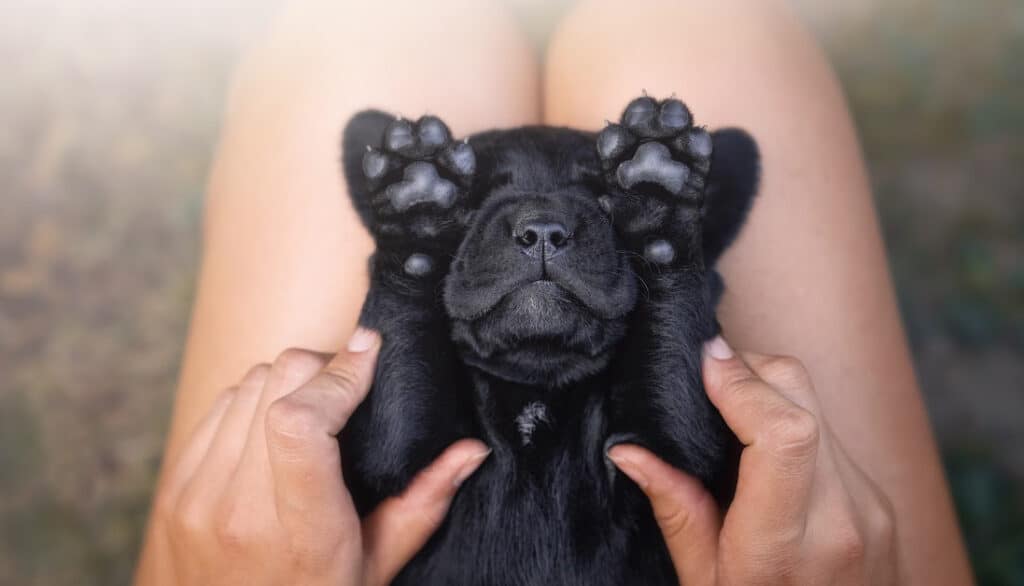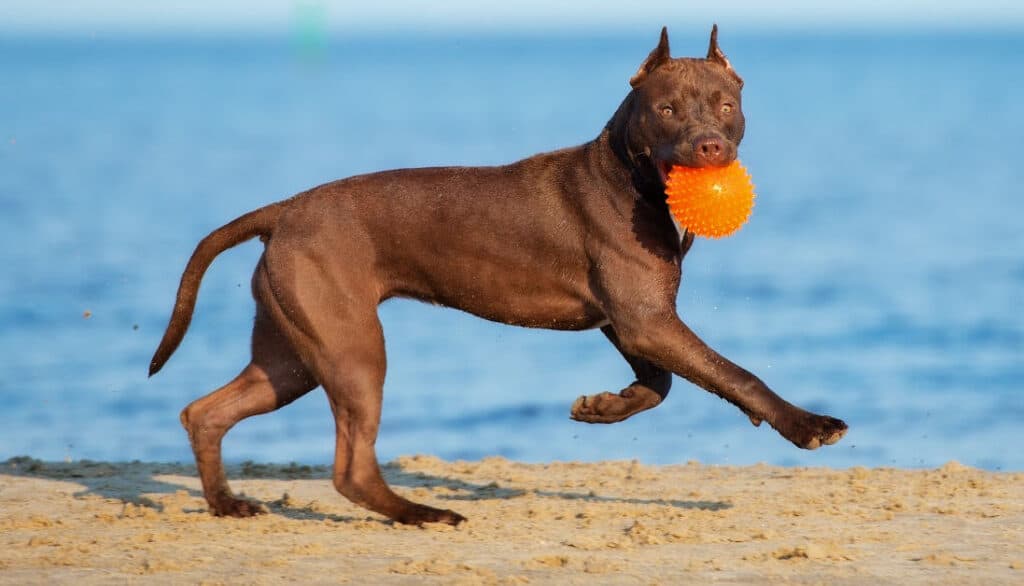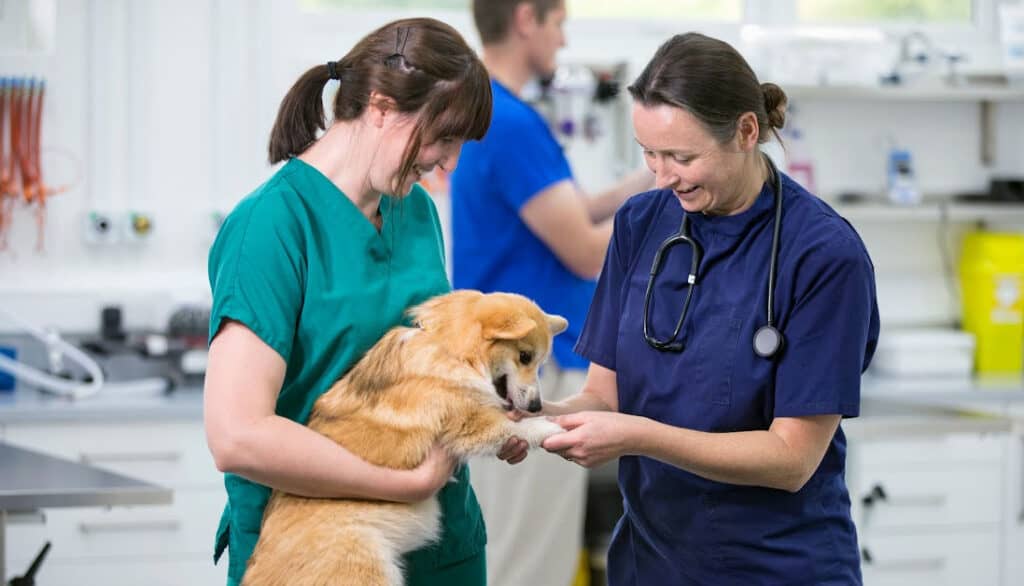Hello, fellow dog lovers and curious minds! If you’re anything like me, you’ve spent a good amount of time studying every unique feature of your beloved furry friend – from the patterns on their coat to the color of their nails. And yes, just like you, I too once puzzled over the peculiar combination of black and white nails on my dog’s paws. It’s like a manicure mystery waiting to be solved!
You might have wondered, “Is it a genetic trait? A health concern? Or just one of those doggy quirks?” Well, you’re in the right place! Today, we’re diving deep into the world of canine nails to uncover the story behind this fascinating blend of colors. By the end of this blog, not only will you have the answers to your questions, but you’ll also gain a new appreciation for the intricacies of dog anatomy and genetics.
So, grab a cup of your favorite beverage, snuggle up with your pup (if they’re into that), and let’s unravel this mystery together! 🐾🔍

Why Does My Dog Have Some Black Nails And Some White?
Every dog owner loves observing their pet, and sometimes, those observations bring up questions. One such query that’s stumped many of us is the mixed color of our dog’s nails. So, why does this happen? Let’s dive in!
Natural Nail Pigmentation Facts
When you look at your dog’s nails, the colors you observe come from the pigments present in the keratin of the nail. Keratin is the protein that makes up nails, both in humans and dogs.
- Genetics Rule: Just like the coat color, eye color, and skin color in dogs, nail color is also inherited. If both parent dogs have a mix of white and black nails, there’s a good chance their offspring will too.
- Melanin Matters: The color of your dog’s nails, whether black or white, is determined by melanin. Black nails have melanin, while white or clear nails lack it. This is similar to the way our hair or skin color is determined by the presence or absence of melanin.
- Breed Specifics: Some breeds are more prone to having mixed nail colors. For example, Beagles and Boxers might sport both colors, while Dalmatians tend to have predominantly white nails.
Fungal Infections & Weird Toe Nail Colors
It’s essential to note that while genetics play a significant role in nail color, other factors can cause changes or irregularities.
- Fungal Infections: If you notice an odd color, texture, or smell from your dog’s nails, it might be due to a fungal infection. This can lead to nails becoming discolored, brittle, or having an unusual growth pattern. While black or white nails can be entirely natural, any sudden change in nail color should be a sign to consult your vet.
- Bacterial Infections: Just like fungal infections, bacterial infections can also cause discoloration. If your dog’s nails turn green, yellow, or another unusual color, it’s essential to get it checked out.
Trauma or Nail Damage
Accidents happen, and sometimes our dogs might hurt their paws or nails while playing, running, or just being their clumsy selves.
- Bruising: If a dog injures its nail, it might develop a dark color due to bruising beneath the nail. This usually looks like a dark spot or streak.
- Broken Nails: If a nail breaks, the exposed nail bed can be sensitive and might appear reddish or pink. This is due to the blood vessels and sensitive tissue exposed due to the break.
- Healing and Regrowth: After an injury, as the nail starts to heal, you might notice a variation in its color. This is temporary, and as the nail grows out, it should return to its natural color.
While genetics is a leading factor in the color of your dog’s nails, various health issues or injuries can cause color changes. Always keep an eye out for sudden or drastic changes and consult with your veterinarian if something seems amiss. Remember, being informed is the first step to ensuring our furry friends stay happy and healthy! 🐾

When to Be Worried About Your Dog’s White Nails
Just when you thought you’ve figured out the mystery behind their mixed nail colors, another question pops up – should I be concerned about those white nails? While it’s common for dogs to have white or clear nails naturally, sometimes, the appearance or changes in these nails can be a cause for concern. Here’s a human-friendly rundown on when those white nails might warrant a vet visit.
Sudden Color Change
If your dog has always had black nails and suddenly you notice a shift to white or clear, this could be a cause for concern. A sudden change in nail color might be due to a number of reasons, including:
- Nutritional Deficiencies: Just like in humans, dogs’ nail health can reflect their overall health. A deficiency in certain vitamins or minerals might manifest as a change in nail color.
- Systemic Illnesses: Some diseases affect multiple organs and systems in the body and can lead to changes in nail color.
Texture and Structural Changes
White nails aren’t just about color. It’s also important to consider their texture and structure.
- Brittleness: If your dog’s white nails suddenly become brittle and start chipping or breaking easily, it’s time to pay attention. This could be due to a fungal infection, nutritional issues, or even an underlying health concern.
- Thickening or Overgrowth: While some dogs naturally have faster-growing nails, a sudden or unusual thickening might indicate a health problem. It’s especially concerning if only one or two nails are affected.
Behavioral Signs
Dogs, being the expressive creatures they are, often show discomfort or pain through their behavior.
- Licking or Biting: If your dog starts excessively licking or biting at their white nails, it might be feeling some discomfort. This could be due to an infection, an injury, or an ingrown nail.
- Limping or Favoring a Paw: Should you notice your dog limping or avoiding putting weight on a paw with white nails, it could indicate pain or an injury related to the nail.
Odor or Discharge
A bad smell coming from your dog’s nails or any kind of discharge (pus or otherwise) is a red flag.
- Fungal or Bacterial Infections: An unpleasant odor, coupled with discoloration or brittle texture, could indicate a fungal or bacterial infection.
- Trauma: If there’s been an injury, an infection might set in, leading to discharge and a bad smell. This needs immediate attention.
While many dogs naturally sport lovely white nails without any issues, it’s crucial for pet owners to be observant. Any change in the appearance, texture, or behavior related to those nails might be your dog’s way of signaling that something’s amiss. When in doubt, always consult with your vet. After all, our four-legged friends rely on us to ensure they’re in tip-top shape! 🐾🩺

What Should Healthy Dogs Nails Look Like?
If you’re anything like me, you’ve probably given those little doggy toes more than just a passing glance. Nails, often overlooked, play a significant role in our pup’s well-being. And just as we’d fret over a broken nail or an unexpected change in nail health, it’s just as crucial to know what’s normal and what’s not for our four-legged buddies. So, what should a healthy dog’s nails look like? Let’s dig in, shall we?
Color Consistency
- Natural Hues: Healthy nails can be black, white, brown, or any shade in between. What’s essential is consistency. If your dog has always had black nails, they should typically remain that color, and the same goes for other hues.
- No Sudden Changes: While it’s okay for a dog to have a combination of colored nails (like a mix of black and white), be on the lookout for any sudden changes in color that aren’t related to the natural growth of the nail.
Texture and Strength
- Smooth to the Touch: Run your fingers over your dog’s nails. They should feel relatively smooth without any rough edges or noticeable ridges.
- Not Too Brittle or Too Soft: Healthy nails shouldn’t break at the slightest pressure, nor should they bend easily. They need to have a certain firmness to them, signifying good health and proper nutrition.
Length and Shape
- Not Touching the Ground: Ideally, when your dog is standing still on a flat surface, their nails shouldn’t touch the ground. Overly long nails can affect their gait and even cause pain or injury.
- Tapered End: A healthy nail should taper to a point, although the sharpness of that point can vary depending on the breed and individual dog.
Quick Health
The quick is the inner part of the nail that contains blood vessels and nerves.
- Visible in Light-Colored Nails: If your dog has clear or white nails, you should be able to see the pinkish quick inside. It should appear uniform and not discolored or spotted.
- Not Exposed: For dogs with dark nails where the quick isn’t visible, ensure it hasn’t been exposed due to any trauma or excessive trimming.
No Signs of Pain or Discomfort
- Comfortable Pawing: Your dog should be able to paw at toys, dig, or scratch without showing signs of pain or discomfort.
- No Excessive Licking or Biting: If your dog is persistently licking or biting at its nails, it might be an indication of a problem.
Remember, while this is a handy guide to understanding what healthy nails should look like, every dog is unique. Regular check-ups with your vet and routine grooming can ensure those paws stay in prime condition. After all, those nails are meant for happy digging, playful scratching, and enthusiastic tapping when dinner’s on its way! 🐾❤️

What Does An Infected Dog Nail Look Like?
We’ve all been there – one moment you’re playing fetch, and the next, you’re squinting down at your dog’s nail thinking, “Is that normal?” An infected nail can be a source of significant discomfort for our furry friends, and knowing what to look for is half the battle. Let’s dive into the world of dog nail health and unpack the signs of an infected nail, shall we?
Color Changes
- Discoloration: Healthy nails should maintain their natural hue, be it black, white, or anything in between. An infected nail might show odd discolorations like yellow, green, or even a murky brown.
- Dark Spots or Streaks: If you spot dark or unusual streaks, especially on lighter-colored nails, it could be a sign of a brewing infection.
Swelling and Redness
- Around the Nail Bed: The skin around the nail might become red, swollen, or tender to touch. This is often a tell-tale sign of an infection.
- Extended Quick: If the quick (the inner sensitive part of the nail) appears swollen or extended, it’s cause for concern.
Odor and Discharge
- Unpleasant Smell: An infected nail might emit a foul or unusual odor. Trust your nose – if it smells off, it probably is.
- Pus or Other Discharge: Notice any oozing around your dog’s nail? A discharge, especially if it’s pus-filled, is a red flag indicating an infection.
Behavioral Clues
- Licking and Biting: Dogs instinctively try to soothe discomfort. If your pup is constantly licking or biting at its nail, it’s trying to tell you something’s wrong.
- Limping or Favoring a Paw: Any sign of pain, like limping or hesitating to put weight on a paw, especially after a recent injury, should prompt a closer look at those nails.
Brittleness or Breakage
- Easy to Break: Infected nails might become brittle, breaking or chipping easily.
- Unusual Growth Patterns: An infected nail might grow oddly or might even halt in growth.
If you’ve done your doggy detective work and suspect an infected nail, don’t panic! While it’s essential to address any infection promptly to prevent it from worsening or spreading, many infections are entirely treatable with the right care and attention. Always consult with your vet, as they’ll provide guidance on treatment options and care.
Remember, our dogs rely on us to keep them healthy and happy. Observing and understanding the signs of potential issues is our way of giving back for all the joy they bring into our lives. Here’s to healthy paws and wagging tails! 🐾🩺🐶

How To Keep Your Dog’s Nails Healthy
Paws up if you want your dog to have the healthiest nails on the block! 🐾 Keeping our furry companions in tiptop shape is not just about their glossy coats or sparkling eyes; their nails play a pivotal role too. Nails that are cared for can prevent injuries, infections, and other complications. So, how do you ensure that those little (or big) claws remain in pristine condition? Let’s dive in!
Regular Trimming
- Importance of Routine: Just like how we need regular manicures or trims, our dogs benefit from a consistent nail-clipping schedule. Overgrown nails can lead to various issues, from discomfort while walking to a higher risk of breakage.
- Choosing the Right Tools: Invest in a good pair of dog nail clippers or grinders. Whether you opt for the scissor-type or guillotine-style, ensure they’re sharp and suited for your dog’s nail size.
- Pace and Technique: If you’re new to nail trimming or if your dog is anxious, start slow. Trim a small bit at a time, always being cautious of the quick. If your dog has clear nails, the quick will appear pink. For darker nails, the process is a tad trickier, so always err on the side of caution.
- Make it a Positive Experience: Associate nail trimming with treats and praises. Over time, your pup might just wag its tail at the sight of those clippers!
Balanced Nutrition
- Role of Diet: Just like humans, dogs’ nail health is a reflection of their overall nutrition. A balanced diet can ensure strong and healthy nails.
- Essential Nutrients: Omega fatty acids, biotin, and proteins play a crucial role in nail health. Ensure your dog’s diet includes these, either through their regular food or supplements (after consulting with a vet, of course!).
- Hydration: Yes, even hydration plays a role! A well-hydrated dog is likely to have healthier nails.
Regular Vet Check-ups
- Professional Insight: Regular vet visits ensure that any potential issues, not just with the nails but overall health, are caught early. Your vet can provide guidance on nail care tailored to your dog.
- Addressing Concerns: If you ever notice abnormalities or changes in your dog’s nails, your vet is the best person to consult. They can offer treatments, solutions, and advice on preventing future problems.
- Recommendations on Products: From suggesting dietary supplements to recommending specific nail care products, your vet can guide you in making the best choices for your pup.
Maintaining your dog’s nail health is a combination of routine care, a balanced diet, and regular professional check-ups. With the right attention and love, those paws will remain ready for countless walks, playful digs, and excited doorbell dances. Here’s to a journey filled with the ‘clip-clip’ of healthy nails on the floor and the unconditional love of our four-legged friends! 🐾🐕❤️
Conclusion
And there we have it, dear dog parents—a comprehensive guide to unraveling the mysteries and nuances of our furry companions’ nails. From understanding the subtle signs of infections to the joy of hearing the gentle tap-tap of healthy nails on the floor, we’ve journeyed through it all. Taking care of our dogs extends far beyond belly rubs and fetching games; it’s in the small details, like nail health, that we truly ensure their well-being.
Every wag, woof, and playful bark reminds us of the boundless joy our dogs bring into our lives. And in return, it’s our job to offer them the best care possible. By prioritizing their nail health, we’re not just looking after a part of their anatomy; we’re ensuring that every step they take is comfortable and happy.
So, the next time you cuddle up with your pup, give those nails a gentle glance. Remember, they’re not just keratin structures but markers of your dog’s overall health. Armed with knowledge, awareness, and love, let’s commit to giving our four-legged family members the healthy and spirited life they so richly deserve.
To all the paw-rents out there, here’s raising a toast (or perhaps a chew toy?) to many more years of wagging tails, excited barks, and, yes, healthy nails! 🐾❤️🎉
Frequently Asked Questions (FAQS)
A: The frequency of nail trims can vary depending on your dog’s activity level and where they spend most of their time. Typically, most dogs will need their nails trimmed every 3-4 weeks. However, if your dog spends a lot of time on rough surfaces that naturally wear down their nails, you might not need to trim them as often.
A: A split nail can be painful for your dog and can potentially lead to infections. Clean the area gently and prevent your dog from licking it. It’s best to consult your vet promptly for proper care and treatment recommendations.
A: Positive reinforcement works wonders. Begin by showing your dog the nail clippers and rewarding them with a treat. Gradually, over time, touch their paws with the clippers, again rewarding with treats. This slow introduction can make the actual trimming process less stressful. Additionally, consider using a grinder instead of clippers, as it can be less intimidating and more forgiving.
A: Symptoms of an infected nail include redness, swelling, an unpleasant odor, pus or discharge, and your dog excessively licking or biting at the nail. If you notice any of these signs, it’s best to consult your vet for a proper diagnosis and treatment.
A: When the quick has grown out with the nail, you should be extra cautious. Trim a small bit of the nail every week, which will encourage the quick to recede gradually. If you’re unsure or nervous about the process, consider seeking a professional groomer or your vet’s assistance to avoid any injuries.
